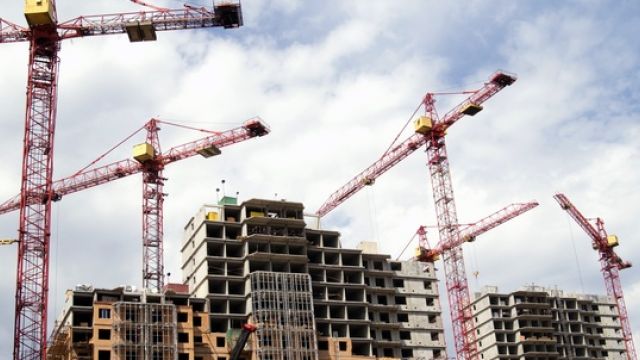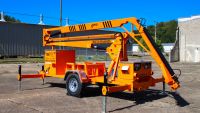
10 construction industry trends to watch in 2016
Analysts predict 2016 will be a strong year for the industry
Now that 2015 has come and gone, construction professionals are focusing attention on the year ahead. Analysts predict 2016 will be a strong year for the industry, as Dodge Data & Analytics' 2016 Construction Outlook report predicted 6% growth, with the value of construction starts reaching an estimated $712 billion.
We talked with experts from various sectors of the construction industry to find out their predictions for 2016. Their answers varied from new technology trends, to workforce concerns, to homebuyer preferences. But one common thread connected all of the experts: They have high hopes that 2016 will bring strong demand and booming business.
"I don’t think I could be any more optimistic for 2016," Bud LaRosa, chief business performance officer and chief financial officer for Tocci Building Companies, told Construction Dive. "These are truly the good times."
Here are the top 10 trends to watch in 2016, according to the experts:
1. Skilled labor shortage will continue to plague construction companies
The most commonly mentioned trend for 2016 was the continued effects of the skilled worker shortage. A significant portion of employees who left the industry during the recession never returned, and companies are still struggling to find workers at all levels to properly staff their teams."The overwhelming, number one issue is access to skilled labor," Dominic Thasarathar, Autodesk's senior industry program manager for construction and natural resources, told Construction Dive. "So many people left the industry or were laid off, and now there's a real struggle to find the right people to staff the projects that are now coming online."
The labor crisis is not a new issue, and most experts predict it will continue well into 2016 and beyond, as the talent deficit will require multiple years to fill up again.
"Not only has the construction industry struggled to appeal to a younger, more technologically savvy workforce, but during the economic downturn, many companies opted not to bring in younger, newer talent," said Tom Menk, an assurance partner with BDO's national real estate and construction practice. "Now, that's causing struggles to fill that gap in the workforce, which is coupled with the need across industries for companies to replace retiring baby boomers."
Another significant concern: The slowdown in immigration has contributed to the already existing labor shortage, as reports have found many workers who returned to Mexico during the recession have not come back to the U.S. due to increased immigration controls and more job opportunities in Mexico.
"I think politically, the environment against immigration has changed some of the workforce dynamics and made it difficult to staff a lot of the trades," LaRosa said. "I think that trend continues. I don't see that easing anytime in the next two to three years."
2. Prefab/offsite construction methods will become more popular
Offsite — also known as modular or prefabricated — construction has been gaining ground as an alternative building method that offers the benefits of reduced construction time, less waste and possible cost savings. As companies struggle to staff job sites and stick to difficult schedules, many have started to turn to prefab as an option that offers more certainty."A lot of use of things like prefabrication, we expect that to be an accelerating trend next year," Thasarathar said.
Ron Antevy, president and CEO of e-Builder, told Construction Dive he has seen a growing use of prefab methods, especially in the healthcare sector.
"(Prefab) is up-and-coming. That's a way to save costs and speed up the time," he said. "Some of the larger owners out there are starting to realize there are efficiencies there, but you have to be doing a certain amount of volume for these kinds of strategies to pay off."
Wider implementation of offsite construction has been somewhat hindered by the design and construction culture, according to experts at the Offsite Construction Expo in September. They also cited the change in the traditional building process that comes with offsite methods as a deterrent for implementing the approach, as contractors and owners struggle to adapt to the varied timeline of decisions and building. Still, the additional certainty that comes with prefab could catalyze the growing trend in 2016.
3. Construction companies will be more cautious about project selection
The crippling recession and lingering labor shortage have spurred another trend among construction industry decision makers: Many are now being more cautious about the amount of new work they can handle, and about growing their companies."(Companies) are not going to overeat. They're only taking the work they can handle," Chris Kennedy, vice president of Suffolk Construction, told Construction Dive. "It's different from the last boom, when people were signing up for work. Everybody still has those recent wounds. They're going to be a lot more cautious about growing a firm bigger than they can handle."
The labor shortage has left employers at all levels forced to take a closer look at the number and size of projects they can handle at once.
"We as general contractors have become a lot more selective of the projects we pursue," Chuck Taylor, director of operations for Englewood Construction, told Construction Dive. "I think the subcontractors are going to be in a very similar position."
4. BIM will become a necessity, and owner interest in the technology will grow
Building Information Modeling has been a growing trend for years, as it is no longer relegated to just the largest firms. Experts have said BIM provides tangible business benefits, no matter the level of implementation. Many have cited BIM's ability to provide more consistent, more accurate and less time-consuming project document generation. In addition, BIM users can expect better collaboration and coordination among the different parties involved in a project, according to industry users."It used to be a nice thing to have, and now it’s a necessity," LaRosa said.
Jay Dacey, president of Integrated Builders, added, "In the bigger jobs, BIM is pretty much a staple right now."
Antevy said he has seen owner interest in BIM grow, as many are now requiring their contractors to utilize the technology.
"The owners have been hands-off as it relates to BIM. It has been for the contractors and designers, so we’re seeing owners start to get more interested in that," he said. "They're interested because there's data there that they can capture and capitalize on."
5. Green building will grow in commercial and residential sectors
Commercial construction has typically led the pack in green adoption, but the residential sector is starting to catch up. The growing trend in both sectors is driven not just by a desire to produce environmentally friendly structures, but by consumer demand, higher-quality results and lifecycle cost savings, according to experts at Greenbuild 2015.Thasarathar said that with larger construction projects, companies are aiming for LEED certification, "even if it's not prescribed."
Dacey added that although developments outside of city centers tend to not prioritize LEED as much, "almost every building design incorporates green principles." He said he expects green building and LEED certification to continue growing in the coming years.
In the residential sector, green building currently accounts for 26-33% of the total residential market and has helped contribute to the industry's recovery after the recession, according to Dodge Data & Analytics.
"I do think (green building) is a growing trend in response to demand," Robert Dietz, an economist with the National Association of Home Builders, told Construction Dive. He pointed to the aging in place movement as a driving force for that demand, as baby boomers are remodeling their current homes and seeking out ways to increase energy efficiency and reduce utility bills.
6. Jobsite accidents and criminal indictments on the rise
Last year, authorities across the U.S. pumped up efforts to seek out contractor misconduct and dish out severe punishment, including criminal charges, for violations and offenses from worker safety issues to corruption. Manhattan even launched the Construction Fraud Task Force in August to investigate "wrongdoing and unsafe practices" in construction, including fraud, bribery, extortion, money laundering, bid rigging, larceny and safety violations. A New York Times report in November also found that construction worker deaths are on the rise in New York City, and safety measures were inadequate on many of the construction sites where deaths occurred and that immigrants represented a disproportionate percentage of those killed.Experts predict this heightened focus on industry wrongdoing will continue into 2016, especially as OSHA will increase its fines this year for the first time since 1990.
Raymond T. Mellon, a senior partner at Zetlin & De Chiara, said he believes construction accidents will increase in New York City this year due to "a dilution of the trained and experienced work force as a result of the continuing red hot construction market." He added, "This will lead to more entry level, unseasoned construction workers not appropriately trained as to the work itself, as well as safety features, on worksites. Combine this with the entry of 'novice developers' who have a tendency to cut corners, and you have the potential for more accidents."
David Pfeffer, chair of the Construction Practice Group at Tarter Krinsky & Drogin, said he predicts there will be more criminal indictments in 2016 because officials "want to make an example." He added that although indictments this year with be the result of past practices, he believes the influx of cases will "help in the long-term future. It definitely has an effect... We have a very good construction industry here. They do listen. The bad contractors generally don't stick around."
7. Booming multifamily sector will slow down as single-family sector picks up steam
Industry analysts have largely agreed that the multifamily sector's hot streak will inevitably cool down, and that slowdown will likely occur in 2016. On the positive side, the single-family sector is expected to pick up steam and see a strong year. In its 2016 Construction Outlook, Dodge Data predicted single-family construction will see a 20% increase in starts this year, while multifamily is expected to post a 7% gain after several years of double-digit increases."I expect the homebuilding sector will continue to show improvement. If anything happens on the multifamily side, I think it will probably level off. The upward slope for multifamily won't be as strong as for single-family," Alex Carrick, CMD's chief economist, told Construction Dive.
Still, single-family housing has a long way to go to return to pre-recession, "normal" levels. During a webinar in November, NAHB Chief Economist David Crowe said single-family construction is currently 53% back to what is considered "normal" levels, and should be 91% of the way there by the end of 2017. Multifamily, on the other hand, is already significantly higher than "normal" levels, currently 32% above the mark. Crowe said the multifamily sector is expected to slowdown in the next two years, coming in 9% higher than "normal" levels at the end of 2017.
8. Laser scanning technology will gain popularity
Although BIM tends to dominate the construction technology narrative, experts pointed to another emerging technology that is having a significant impact on the industry: laser scanning. 3-D laser scanners can create a digital reproduction of the dimensions and positions of objects in a certain space, and then turn that information into a point cloud image."Laser scanning I think has a lot of room to run. Not as many people are using it, but it's a great tool to measure more precisely than most conventional ways," LaRosa said. "What the laser scanner allows you to do is get millions of data points and put that into a building information model and provide much more information about conditions you couldn't get previously. Look for that to continue to grow certainly next year and for another five years."
Taylor added that laser technology allows contractors to precisely "define to the client where we had issues with the existing floor," and then make the necessary changes.
9. Remodeling will have a strong year, especially in the luxury market
Along with strength in the single-family market this year, experts also predict the remodeling sector will have a banner year in 2016."We're encouraged by recent data that shows consumers have a strong desire to invest in their homes. In fact, survey respondents are indicating that growth in their home improvement spending is outpacing increases in their overall spending," Mike Horn, vice president of Lowe's ProServices, told Construction Dive. "The number of homeowners indicating that their home improvement spending increased has doubled since 2012. This trend underscores the great opportunity our professional contractors have to meet the needs of 75 million homeowners, in addition to the 5 million who relocate or move into a new home each year, across the country increasingly willing to engage in home improvement in 2016."
Bob Ernst, president of the Building & Remodeling Association of Greater Boston, said he projects significant growth in the remodeling sector this year.
"Through all of the ups and downs, this is the first time I feel very comfortable," he told Construction Dive.
Ernst emphasized the luxury market in particular as offering the most opportunity for remodelers. "At that market level, they’re spending money," he said. He noted, however, that the middle and lower markets haven't reached the demand level exhibited in luxury markets, as people in those markets are still struggling to save up enough money for their homes. "People serving primarily those markets might not have as rosy of an outlook," he said.
10. Homebuyers will seek out simple, walkable communities
Last month, the American Institute of Architects released the results of its third-quarter Home Design Trends Survey and found that design elements such as access to public transportation, multi-generational housing, walkable neighborhoods and mixed-use facilities dominate homeowner preferences. "There has been a pronounced shift in driving habits over the last few years, with increasing numbers of people being far more interested walking and utilizing public transit options," AIA Chief Economist Kermit Baker said in a release. "With that is a desire for proximity to employment and commercial activities."The AIA survey coincided with a National Association of Realtors survey over the summer that found walkable communities are growing in popularity among Americans of all ages, particularly millennials. Based on the results of the survey, the NAR advised developers aiming to reach the millennial demographic to consider building attached homes within walking distance of shops and restaurants and nearby public transportation. Baby boomers have reportedly expressed similar desires for their homes, as a Washington Post report in October found retiring baby boomers are downsizing and buying smaller homes in urban areas at twice the rate of millennials.
Jerry James, president of Edward R. James Homes, said he predicts baby boomers will continue to drive the new-home construction market this year. He agreed with the NAR and AIA predictions and said he believes boomers want "simplification" driven by a desire to live in locations that allow them to walk to nearby restaurants and shops.
About the Author
Emily Peiffer is the associate editor of Industry Dive’s Construction Dive publication. Hailing from Lancaster, PA, she received her BA from Susquehanna University. Before joining Industry Dive, Emily worked for Lancaster Newspapers and Science & Diplomacy, under the American Association for the Advancement of Science.
This article was originally published in Construction Dive. This content has been republished with the permission of the publisher.


















